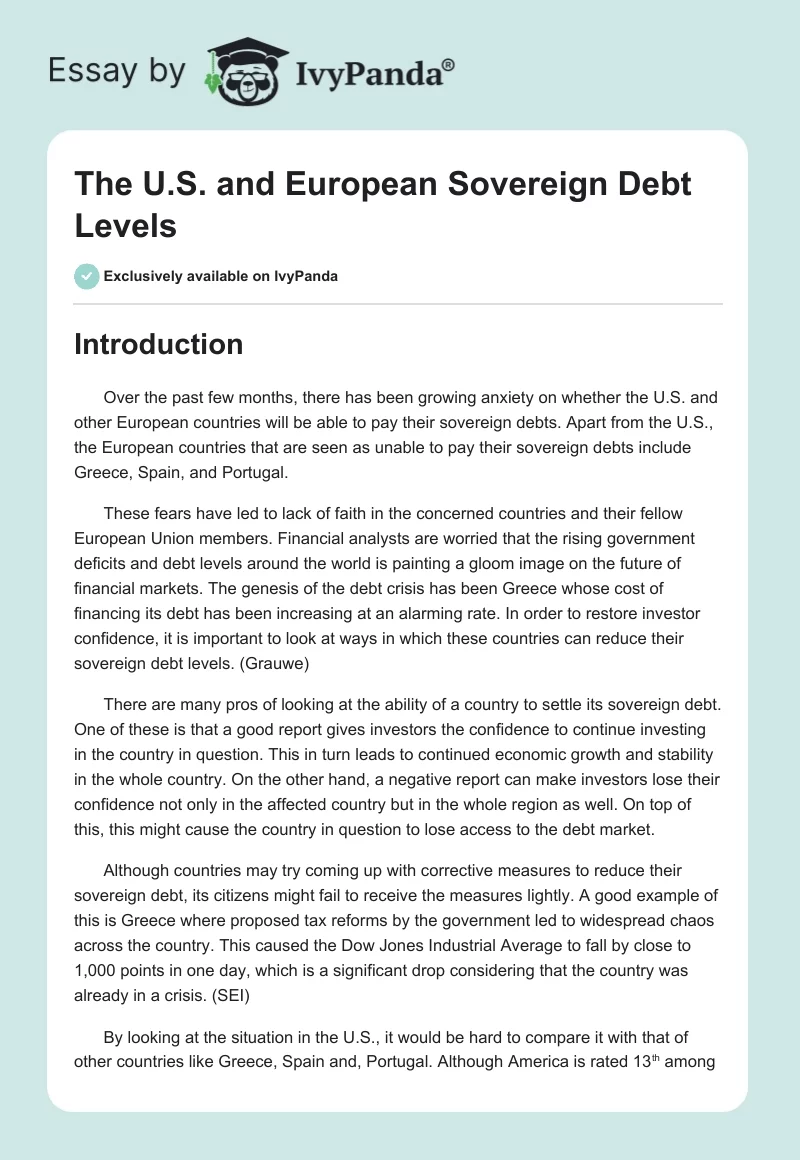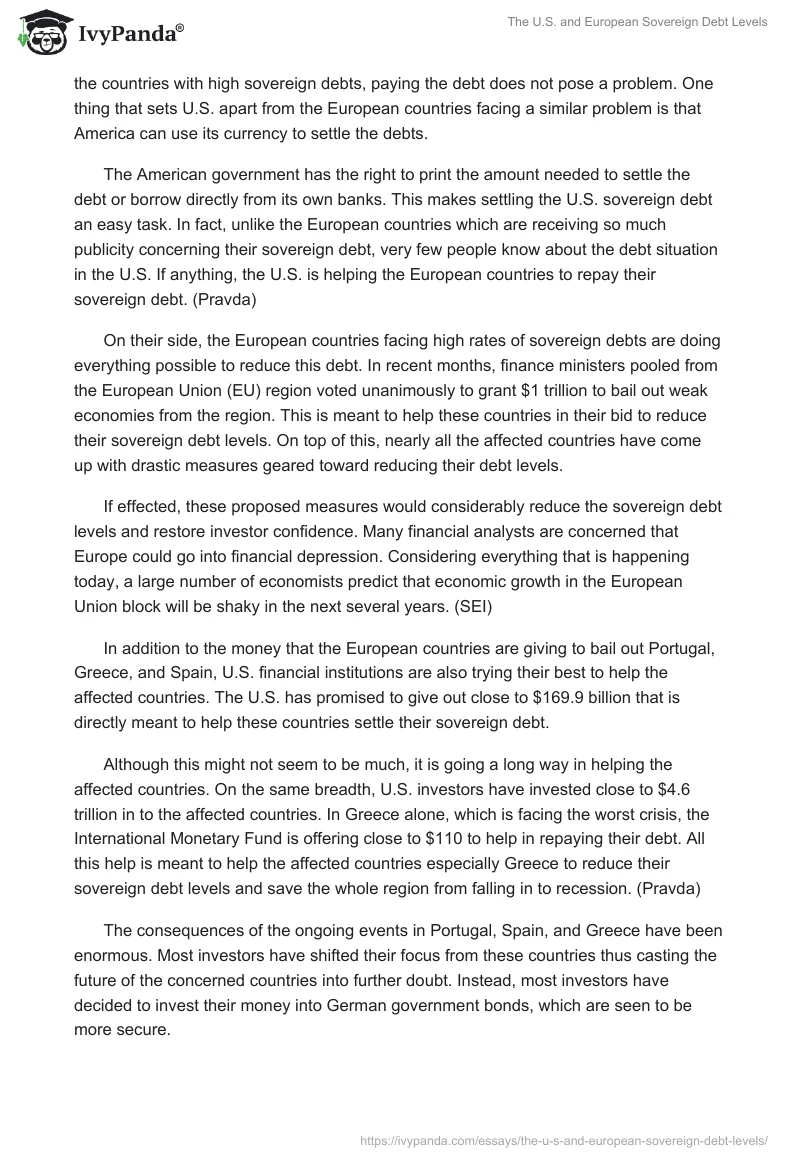Introduction
Over the past few months, there has been growing anxiety on whether the U.S. and other European countries will be able to pay their sovereign debts. Apart from the U.S., the European countries that are seen as unable to pay their sovereign debts include Greece, Spain, and Portugal.
These fears have led to lack of faith in the concerned countries and their fellow European Union members. Financial analysts are worried that the rising government deficits and debt levels around the world is painting a gloom image on the future of financial markets. The genesis of the debt crisis has been Greece whose cost of financing its debt has been increasing at an alarming rate. In order to restore investor confidence, it is important to look at ways in which these countries can reduce their sovereign debt levels. (Grauwe)
There are many pros of looking at the ability of a country to settle its sovereign debt. One of these is that a good report gives investors the confidence to continue investing in the country in question. This in turn leads to continued economic growth and stability in the whole country. On the other hand, a negative report can make investors lose their confidence not only in the affected country but in the whole region as well. On top of this, this might cause the country in question to lose access to the debt market.
Although countries may try coming up with corrective measures to reduce their sovereign debt, its citizens might fail to receive the measures lightly. A good example of this is Greece where proposed tax reforms by the government led to widespread chaos across the country. This caused the Dow Jones Industrial Average to fall by close to 1,000 points in one day, which is a significant drop considering that the country was already in a crisis. (SEI)
By looking at the situation in the U.S., it would be hard to compare it with that of other countries like Greece, Spain and, Portugal. Although America is rated 13th among the countries with high sovereign debts, paying the debt does not pose a problem. One thing that sets U.S. apart from the European countries facing a similar problem is that America can use its currency to settle the debts.
The American government has the right to print the amount needed to settle the debt or borrow directly from its own banks. This makes settling the U.S. sovereign debt an easy task. In fact, unlike the European countries which are receiving so much publicity concerning their sovereign debt, very few people know about the debt situation in the U.S. If anything, the U.S. is helping the European countries to repay their sovereign debt. (Pravda)
On their side, the European countries facing high rates of sovereign debts are doing everything possible to reduce this debt. In recent months, finance ministers pooled from the European Union (EU) region voted unanimously to grant $1 trillion to bail out weak economies from the region. This is meant to help these countries in their bid to reduce their sovereign debt levels. On top of this, nearly all the affected countries have come up with drastic measures geared toward reducing their debt levels.
If effected, these proposed measures would considerably reduce the sovereign debt levels and restore investor confidence. Many financial analysts are concerned that Europe could go into financial depression. Considering everything that is happening today, a large number of economists predict that economic growth in the European Union block will be shaky in the next several years. (SEI)
In addition to the money that the European countries are giving to bail out Portugal, Greece, and Spain, U.S. financial institutions are also trying their best to help the affected countries. The U.S. has promised to give out close to $169.9 billion that is directly meant to help these countries settle their sovereign debt.
Although this might not seem to be much, it is going a long way in helping the affected countries. On the same breadth, U.S. investors have invested close to $4.6 trillion in to the affected countries. In Greece alone, which is facing the worst crisis, the International Monetary Fund is offering close to $110 to help in repaying their debt. All this help is meant to help the affected countries especially Greece to reduce their sovereign debt levels and save the whole region from falling in to recession. (Pravda)
The consequences of the ongoing events in Portugal, Spain, and Greece have been enormous. Most investors have shifted their focus from these countries thus casting the future of the concerned countries into further doubt. Instead, most investors have decided to invest their money into German government bonds, which are seen to be more secure.
Because of this, bond yields for the affected countries have gone up by a substantial amount. This descending price impetus for bonds issued by the affected countries can only be likened to the trend experienced among U.S. financial sector during the economic meltdown experienced in 2008. These market patterns are both worrying and creating concern to investors and the whole European Union region. (SEI)
Personally, I think that the problem in these European countries is more complicated than it is being admitted. Although the U.S. has a high sovereign debt level, it is the least of my worries since the country is well capable of settling its debt if it so wishes. However, the countries that I am concerned about are Portugal, Spain, and Greece. By studying the events, I highly doubt that these countries and especially Greece will succeed in their pledge to reduce its fiscal deficit.
I am worried that the crisis is still deepening despite numerous pledges by the IMF and other European countries to help the countries in settling their sovereign debts in the near future. Clearly, I think that the next few months will witness a further decline of the euro as compared to the dollar. If this trend continues, I think there will be a high possibility that Greece, Spain, and Portugal will default in reducing their sovereign debt levels. (Grauwe)
Conclusion
In recent months, there has been increasing concern from investors on the ability of some European countries to reduce their sovereign debt levels. This has caused investors to abandon their bid of investing in these countries in favor of other stable economies like Germany.
In the event where these countries default in reducing their sovereign debt levels, the whole European Union region will definitely be affected. This has seen other countries in the block doing everything possible to help these countries reduce their debt. However, the efforts by these countries are yet to bear fruit since the debts of the affected countries continue to grow.
Works Cited
Grauwe, Paul. Fighting the Wrong Enemy, 2010. Web. Oct 7. 2010. <https://voxeu.org/article/europe-s-private-versus-public-debt-problem-fighting-wrong-enemy>
Pravda. Why US Need Not Fear Sovereign Crisis: Unlike Greek, It’s Sovereign, 2010. Web. Oct 8. 2010. <http://www.pravdareport.com/business/114386-sovereign_debt_crisis/>
SEI. An Update on the Greek Sovereign Debt Crisis, 2010. Web. Oct 7. 2010. <https://seic.com/>


